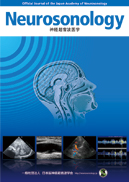All issues

Volume 25 (2012)
- Issue 3 Pages 137-
- Issue 2 Pages 79-
- Issue 1 Pages 5-
Volume 25, Issue 1
Displaying 1-4 of 4 articles from this issue
- |<
- <
- 1
- >
- >|
Atlas of Neurosonology
-
Masahiro YASAKA, Yoshiyuki WAKUGAWA, Yasushi OKADAArticle type: Atlas of Neurosonology
2012 Volume 25 Issue 1 Pages 5-6
Published: October 15, 2012
Released on J-STAGE: November 12, 2012
JOURNAL FREE ACCESSDownload PDF (601K)
Original Articles
-
Ayaka NUMAO, Keisuke SUZUKI, Hidehiro TAKEKAWA, Masayuki MIYAMOTO, Tom ...Article type: Original Articles
2012 Volume 25 Issue 1 Pages 7-12
Published: October 15, 2012
Released on J-STAGE: November 12, 2012
JOURNAL FREE ACCESSObjective: Hyperechogenicity in the midbrain substantia nigra (SN) on transcranial sonography (TCS) images has been reported in Parkinson’s disease (PD). We used a semi-quantitative evaluation method, the Gray Scale Median, to quantify echogenic changes.
Subjects: Hospitalized patients with PD (n = 7) or Parkinsonian syndrome (PS) (n = 7) and in-hospital control subjects (n = 6) were included. The PS group consisted of cases of progressive supranuclear palsy (n = 3), multiple system atrophy (n = 2), and corticobasal degeneration (n = 2).
Methods: The subjects were evaluated using TCS. The SN was identified within the midbrain and the areas with echogenic signals were circled and measured. Next, echogenic signals in the SN and dorsal midbrain (DM) were converted into gray scale using Photoshop software (Adobe Systems Inc., Tokyo, Japan) and the median gray scale values of the SN and DM were obtained using a histogram. The SN-to-DM ratio was calculated.
Results: Compared with the PS and control groups, the PD group had an increased SN-to-DM ratio and a larger SN hyperechogenic area. The SN-to-DM ratio correlated positively with the SN hyperechogenic area.
Conclusion: A semi-quantitative evaluation of echogenic signal changes using the SN-to-DM ratio may be useful for the objective evaluation of SN signal changes.View full abstractDownload PDF (533K)
Case Report
-
Naoko TAKAMATSU, Yuka TERASAWA, Waka SAKAI, Ryosuke MIYAMOTO, Ai MIYAS ...Article type: Case Report
2012 Volume 25 Issue 1 Pages 13-16
Published: October 15, 2012
Released on J-STAGE: November 12, 2012
JOURNAL FREE ACCESSA case in which the presence of nodules on muscle ultrasonography led to the diagnosis of muscular sarcoidosis is described. A 58-year-old woman was admitted to our hospital with blepharoptosis and diplopia, as well as gradually progressive leg pain. Muscle ultrasonography showed 2- to 3-mm-diameter, cystic nodules in the right tibialis anterior muscle. In the same muscle, myogenic changes were seen on needle electromyography. A muscle biopsy of the region where the nodules were detected was performed. The biopsy specimen showed noncaseating granulomas, and sarcoidosis was diagnosed. Ultrasonography is useful to identify regions to biopsy in patients with muscular sarcoidosis.View full abstractDownload PDF (689K)
Technical Note
-
Kentaro HAYASHI, Kensaku KAMADA, Takayuki MATSUO, Nobutaka HORIE, Izum ...Article type: Technical Note
2012 Volume 25 Issue 1 Pages 17-20
Published: October 15, 2012
Released on J-STAGE: November 12, 2012
JOURNAL FREE ACCESSThe endoscopic treatment for neurological disease has become widespread. Recently, endoscopic evacuation of an intracerebral hematoma has been introduced. The advantage of endoscopic treatment is that it is less invasive. However, the surgical field is limited and evaluation of the entire lesion is not possible. Here, we report the usefulness of burr-hole ultrasonography for endoscopic treatment. An ultrasound scanner (ALOKA SSD-2000, Tokyo, Japan) and a small transducer with a bayonet-style handle and a straight, untapered head (ALOKA UST-5268P-5, 3.0-8.0 MHz, phased-array sector probe) were used. After opening a standard burr-hole, the transducer was placed in the operative field and the intracranial lesion was examined. A postoperative computed tomography (CT) scan was obtained in each case to corroborate the appropriate procedures performed with ultrasonography. The endoscopic treatment was performed for two cases of putaminal hemorrhage and one case of cerebellar hemorrhage. Intraoperative ultrasonography provided real-time information about the location, distance, and trajectory of the lesions. Moreover, the removal of the lesion was confirmed. The result of the postoperative CT scan was consistent with findings of intraoperative ultrasonography. No procedure-related complication was noted and the disadvantage was minimal. Intraoperative ultrasonography using a burr-hole transducer has proved to be useful in endoscopic treatment.View full abstractDownload PDF (4249K)
- |<
- <
- 1
- >
- >|